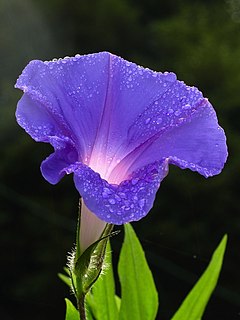
Morning glory is the common name for over 1,000 species of flowering plants in the family Convolvulaceae, whose current taxonomy and systematics are in flux. Morning glory species belong to many genera, some of which are:

Ipomoea is the largest genus in the flowering plant family Convolvulaceae, with over 600 species. It is a large and diverse group, with common names including morning glory, water convolvulus or kangkung, sweet potato, bindweed, moonflower, etc.

Ipomoea alba, sometimes called the tropical white morning-glory or moonflower or moon vine, is a species of night-blooming morning glory, native to tropical and subtropical regions of North and South America, from Argentina to northern Mexico, Florida and the West Indies. Though formerly classified as genus Calonyction, species aculeatum, it is now properly assigned to genus Ipomoea, subgenus Quamoclit, section Calonyction.

Rubus leucodermis, also called whitebark raspberry, blackcap raspberry or blue raspberry, is a species of Rubus native to western North America, from Alaska south as far as California, Arizona, New Mexico, and Chihuahua.

Ipomoea quamoclit, commonly known as cypress vine, cypress vine morning glory, cardinal creeper, cardinal vine, star glory, star of Bethlehem or hummingbird vine, is a species of vine in the family Convolvulaceae native to tropical regions of the New World and naturalized elsewhere in the tropics.

Ipomoea pes-caprae, also known as bayhops, bay-hops, beach morning glory or goat's foot, is a common pantropical creeping vine belonging to the family Convolvulaceae. It grows on the upper parts of beaches and endures salted air. It is one of the most common and most widely distributed salt tolerant plants and provides one of the best known examples of oceanic dispersal. Its seeds float and are unaffected by salt water.
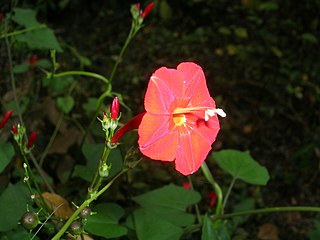
Ipomoea hederifolia is a species of herbaceous annual vine native to the Americas. It was first described by Linnaeus in 1759.

Ipomoea indica is a species of flowering plant in the family Convolvulaceae, known by several common names, including blue morning glory, oceanblue morning glory, koali awa, and blue dawn flower. It bears heart-shaped or 3-lobed leaves and purple or blue funnel-shaped flowers 6–8 cm (2–3 in) in diameter, from spring to autumn. The flowers produced by the plant are hermaphroditic. This plant has gained the Royal Horticultural Society's Award of Garden Merit.

Ipomoea hederacea, the ivy-leaved morning glory, is a flowering plant in the bindweed family. The species is native to tropical parts of the Americas, and has more recently been introduced to North America. It now occurs there from Arizona to Florida and north to Ontario and North Dakota. Like most members of the family, it is a climbing vine with alternate leaves on twining stems. The flowers are blue to rose-purple with a white inner throat and emerge in summer and continue until late fall. The leaves are typically three-lobed, but sometimes may be five-lobed or entire. Flowers occur in clusters of one to three and are 2.5-4.5 cm long and wide. The sepals taper to long, recurved tips and measure 12–24 mm long. The species shares some features with the close relative Ipomoea purpurea.

Ipomoea nil is a species of Ipomoea morning glory known by several common names, including picotee morning glory, ivy morning glory, and Japanese morning glory. It is native to the tropical Americas, and has been introduced widely across the world.
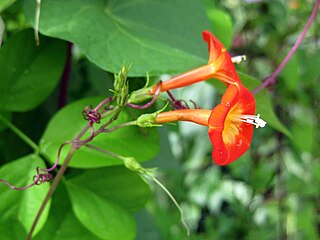
Ipomoea coccinea is a flowering plant in the family Convolvulaceae known by several common names including red morning glory, redstar and (ambiguously) Mexican morning glory.
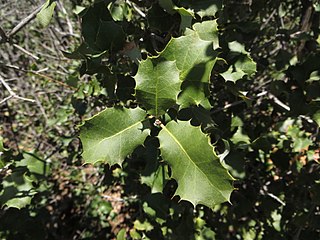
Quercus palmeri is a species of oak known by the common name Palmer oak, or Palmer's oak. It is native to California, Baja California, Southern Nevada, and in Arizona through the transition zone to the eastern Mogollon Rim, where it grows in canyons, mountain slopes, washes, and other dry habitats. Quercus dunnii Kellogg 1879, common name Dunn oak, is synonymous with Palmer oak. Palmer oak does not occur in New Mexico as the specimen were misidentified and later corrected to Quercus grisea on seinet were the collection records are maintained. The population of golden oaks in Apache Box near Arizona appear to be integrated Quercus chrysolepis Affinity palmeri as stated in the FNA. The population is not Q. palmeri but mostly Q. chrysolepis with past hybridization with Q. palmeri. Quercus palmeri was recently discovered in Southern Nevada in Christmas tree pass that was previously only know from fossils.
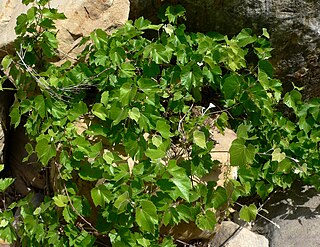
Vitis arizonica is a North American species of wild grape. It is a deciduous vine.

Ipomoea lacunosa, the whitestar, white morning-glory or pitted morningglory, is a species that belongs to the genus Ipomoea. In this genus most members are commonly referred to as "morning glories". The name for the genus, Ipomoea, has root in the Greek words ips and homoios, which translates to worm-like. This is a reference to the plant's vine-like growth. Lacunosa comes from a Latin word meaning air spaces, correlating with the venation of the leaves. Ipomoea lacunosa is native to the United States and grows annually. The flowers of this species are usually white and smaller than most other morning glories.
Phaseolus angustissimus is a perennial, herbaceous vine of the Fabaceae (legume) family, native to the American Southwest, as well as northern Sonora, Mexico. It is a close relative of the cultivated tepary bean, also native to the same region.

Passiflora bryonioides, the cupped passionflower, is a plant in the genus Passiflora, family Passifloraceae. It is native to northern Mexico and the south-western United States (Arizona).

Bouteloua repens, colloquially known as slender grama, is a grass species in the grama genus native to the southwestern United States and northern Mexico.
Psorothamnus scoparius is a thornless bush in the bean family (Fabaceae), native to North America. It is known as broom smokebush and broom dalea.

Townsendia hookeri is a perennial, flowering plant in the family Asteraceae. It is often referred to by the common names Easter daisy or Hooker's Townsend daisy. Named after 19th century botanist William Jackson Hooker, T. hookeri shares the genus Townsendia with at least 28 other species at this time.
Ipomoea aurantiaca is a species of morning glory found in Costa Rica, Mexico, Guatemala, and Nicaragua. It is a twining vine that has yellow flowers.

















